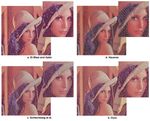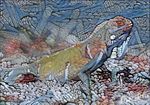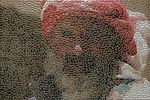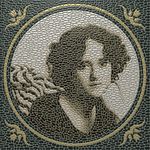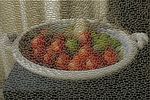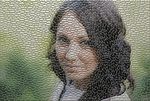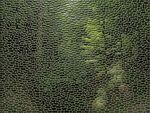Automated pebble mosaic stylization of images
←
→
Page content transcription
If your browser does not render page correctly, please read the page content below
Automated pebble mosaic stylization of images
Lars Doyle Forest Anderson Ehren Choy David Mould
lars.doyle@carleton.ca, forest.anderson@carleton.ca ehren.choy@gmail.com mould@scs.carleton.ca
Carleton University, Ottawa, Canada
Abstract
arXiv:1902.02806v1 [cs.GR] 7 Feb 2019
Digital mosaics have usually used regular tiles, simu-
lating the historical “tessellated” mosaics. In this paper,
we present a method for synthesizing pebble mosaics, a
historical mosaic style in which the tiles are rounded
pebbles. We address both the tiling problem, where peb-
bles are distributed over the image plane so as to approx-
imate the input image content, and the problem of ge-
ometry, creating a smooth rounded shape for each peb-
ble. We adapt SLIC, simple linear iterative clustering, to
obtain elongated tiles conforming to image content, and
smooth the resulting irregular shapes into shapes resem-
bling pebble cross-sections. Then, we create an interior
and exterior contour for each pebble and solve a Laplace
equation over the region between them to obtain height- Figure 1. Fragment of a pebble mosaic floor dating from the 4th
field geometry. The resulting pebble set approximates century BCE
the input image while presenting full geometry that can
be rendered and textured for a highly detailed represen-
tation of a pebble mosaic. an initial segmentation, smoothing the resulting boundaries,
and using a Poisson solver to interpolate a smooth height-
field for each pebble which we can then render using con-
1. Introduction ventional lighting and texturing.
Mosaics are an art form that dates back thousands of For a mosaic to successfully convey an image, it is im-
years. The earliest historical mosaics were pebble mo- portant to align tile edges with image edges. The use of
saics [6, 20], whose component pebbles were heteroge- square tiles imposes severe restrictions on the detail level
neous in size and shape. Pebble mosaics were floors paved that can be captured; our irregular tiles can convey consid-
with pebbles, where the pebbles were arranged so as to form erable details, including interior edges of figures, something
an image or design. The craft of pebble mosaics continues often neglected in previous techniques. Our algorithm is
into the 21st century [14] with new pebble mosaics being entirely automatic; users can optionally guide the output by
built by hobbyists and city planners. annotating the input image with an importance map or man-
Pebble mosaics, as well as the contemporaneous chip ually adding decorative features in a preprocessing phase.
mosaics made of fragments of quarried stone [6], use en- This paper makes two main contributions. First, we
tirely irregular tiles. The archetypal mosaic is the tessel- adapt SLIC so that it is suitable for creating irregular, elon-
lated mosaic, made of regular cubes of stone (tesserae). The gated pebble shapes. We estimate the local direction of the
tessellated mosaics are most familiar to us and have been the image and then bias the SLIC clustering distance according
most thoroughly studied in computer graphics. Tessellated to a local coordinate system, producing natural-looking size
mosaics have been dated to the third century BCE. How- and aspect ratio variations. Second, we compute smooth
ever, pebble mosaics appeared in Greece hundreds of years pebble geometry for the resulting tiles. We use the Laplace
earlier [6] and have not received much attention in computer equation, setting up constraints and then solving to meet
graphics. In this paper, we propose a novel algorithm for ir- them, thus producing smooth shapes resembling river peb-
regular pebble mosaics, using a variant of SLIC [1] to obtain bles. By creating and rendering this geometry, we bridge
1Figure 2. An image progressing through our system from left to right: input, segmentation, boundary smoothing, pebble geometry, lighting.
photorealism and non-photorealism. image edges.
The paper is organized as follows. Section 2 reviews pre- Within the multi-picture mosaic branch a thread of re-
vious works on computer-generated mosaics. Section 3 de- search involves populating a set of container shapes with
scribes our algorithm in detail. Section 4 shows images cre- tiles, generally without any intention of providing interior
ated using our method and discusses its benefits and draw- image detail. Kim and Pellacini’s Jigaw Image Mosaic [18]
backs. Finally, Section 5 summarizes the work and suggests is an example, where the method produces an irregular
future directions. tiling of the image plane with predefined tiles, minimiz-
ing a set of error criteria including tile overlap and color
2. Related work mismatch. More recent work by Saputra et al. [25, 24]
arranges figures within the container shape while seek-
Battiato et al. [2] propose a taxonomy of digital mosaic ing an aesthetic distribution rather than a full packing.
research where the two initial branches divide tile mosaics Kwan et al. [19] accelerate partial-shape matching, through
from multi-picture mosaics. This distinction stems from the their pyramid of arclength descriptor, for packing irregular
nature of the basic picture elements. In tile mosaics, the shapes.
image plane is divided into small regions, each individually Other methods for distributing primitives and tiling the
colored to represent the underlying input image. In contrast, plane have been devised, and we briefly mention a few oth-
multi-picture mosaics employ a dataset of images that are ers. Smith et al. [29] focussed on coherent movement of
used to assemble an approximation to the input image based tiles to create animated mosaics; later, Dalal et al. [4] used
on local color and structure similarity; the typical result is Fourier transforms to find good packings of input primi-
a photomosaic [28]. We situate our current work within the tives. Kaplan and Salesin [16, 17], worked on automati-
tile mosaic branch. cally controlling tile shapes to produce Escher-like tilings
In the seminal “Paint by Numbers” [11], Haeberli intro- where the tiles were close to an input goal shape. Similarly,
duced many of the concepts that have since been used for Goferman et al. [9] extract irregular regions of interest from
mosaic emulation. His idea of using Voronoi diagrams for a series of photographs and pack them in a puzzle-like man-
mosaics has been used in commercial products and in subse- ner within a chosen aspect ratio. Photo collage is a related
quent research; Centroidal Voronoi Diagrams (CVD’s) are area, but removes the constraint that an underlying image or
particularly common. CVD’s are often achieved by Lloyd’s containing shape must be represented. Using convolutional
algorithm, a relaxation process that repeatedly moves the neural networks, Liu et al. [21] produce photo collages by
Voronoi centres to the centroids of their regions. The CVD grouping together images with similar content over the im-
process has formed the basis for considerable work in mo- age plane.
saic and stipple creation [12, 27, 13], since it is a good way
to distribute points on the plane. 3. Constructing Pebble Mosaics
Hausner [12] presented an iterative algorithm for plac-
ing mosaic centres, using hardware-accelerated CVD’s to In our approach, we tile the image plane using hetero-
distribute tiles. Hausner also identified a crucial issue geneous, 3D pebble-shaped objects. As in previous meth-
in mosaics: that tile edges should be aligned with im- ods [12, 7, 5], our tiles avoid crossing image boundaries
age edges. Hausner resolved this in his work by having and are oriented to align with a direction map. However,
tiles move away from user-specified edges. An alternative we take a different approach towards this goal. Section 3.1
method for achieving edge alignment was given by Elber describes how we modify the Simple linear iterative cluster-
and Wolberg [7], who arrange rows of tiles along stream- ing algorithm (SLIC) [1] to produce oriented pebble shapes.
lines parallel to initial user-specified curves. Yet another We take advantage of the inherent boundary-avoiding qual-
way of addressing edge alignment was given by Di Blasi ity of SLIC and thus have no need for explicit edge detec-
and Gallo [5], who propose to cut the rectangular tiles where tion nor associated parameters or thresholds. We describe
they cross image edges. Liu et al. [22] use graph cuts rather how we simplify the boundaries of the initial segmentation
than explicit edge detection to prevent tiles from crossing in Section 3.2 to produce smooth, ‘river-worn’ pebbles. Fi-nally, in Section 3.3 we construct a heightfield from the 2D
boundaries to extend pebbles into 3D, applying lighting to
the resulting geometry. A schematic representation of our
algorithm pipeline shows how an input image I is trans-
formed into a pebble mosaic in Figure 3.
Figure 4. Top left: original SLIC; top right: scaling vy in Equa-
tion 1 by α = 3; bottom left: scaling ~v · b~1 in Equation 3 by α = 3;
bottom right: using random scaling in Equation 3.
ble parallel to an edge. We can approximate this effect with
one further modification to our distance metric. First, we
construct a structure tensor [3] at each super-pixel center by
integrating the matrix field, ∇I∇I T , weighted by a Gaus-
sian function. The tensor’s unit eigenvectors e1 and e2 , as-
sociated with eigenvalues λ1 ≥ λ2 , point parallel and per-
pendicular to the smoothed image gradient. We can now
Figure 3. Pipeline of our proposed method.
use these vectors as a new basis in our distance calculation.
Furthermore, applying a larger weight to the component of
3.1. Segmentation ~v parallel to e1 than e2 will allow super-pixels to spread
tangent to image edges. This effect can be seen in Figure 4
SLIC produces compact super-pixels by clustering pix-
on the bottom left. In flat or corner regions, where there is
els into groups, based on colour and spatial distance. Their
inadequate orientation information, we simply assign a de-
tendency to adhere to image boundaries is beneficial for de-
fault direction. This assessment is made by thresholding an
scribing image content and forms the basis of our pebble
orientation coherence estimate:
shapes. In its original formulation, the spatial distance of a
pixel p from a cluster center c can be described by an offset r
λ1 − λ2
vector ~v = p − c, allowing us to compute the l2 distance as: C= , (2)
q λ1 + λ2 + K
Ds = vx2 + vy2 , (1)
where K is a constant chosen to avoid division by zero and
where vx and vy are the components of ~v parallel to the x to de-emphasize weak tensors.
and y-axes. It is often the case in nature that pebbles are The final distance metric is:
longer in one dimension than the other, forming approxi- q
mate, oval-like boundaries as opposed to circular. As a first Ds = α1~v · b~1 + α2~v · b~2 , (3)
modification to Equation 1 we can apply different scaling
factors to the x and y components of ~v . This results in the where α1 and α2 are scaling factors, controlling both the
elongated super-pixels that are shown in the top right image aspect ratio and the overall size of each cluster. The vectors
of Figure 4. b~1 and b~2 correspond either to the local image orientation, if
Artists often take advantage of pebble shapes and will there a strong local orientation exists, or a default direction.
emphasize image edges by aligning the long side of a peb- The decision is made by comparing C to a threshold TcohFigure 5. Left: original contour; remaining images: reconstructing
the contour from L = 37, 17, and 7 Fourier coefficients.
Figure 7. Left: the domain, Ω, and boundaries (co and ci ) of Pi ;
right: the gradient orientation on co (arrows) and zero-gradient on
ci (dots).
this stage we can obtain a resolution-independent, tiled im-
age P by applying a scale factor to the Fourier coefficients,
obtaining a larger (or smaller) co as needed. As seen in Fig-
ure 6, one advantage of rendering at a higher resolution is
the increased surface area that can be used for adding tex-
ture and lighting. Finally, each pebble Pi ∈ P is updated
Figure 6. High-resolution pebbles rendered at 5 times the input by flood filling its corresponding co .
resolution; left: pebble shapes; right: 3D rendered pebbles.
3.3. Pebble geometry
as follows: We construct a heightfield for each pebble by means of
( ( harmonic interpolation over the domain, Ω, that resides be-
e~1 C > Tcoh e~2 C > Tcoh tween two contours (Figure 7, left). The outer contour,
b~1 = ~ and b~2 = . (4) co , is described above. We obtain the inner contour, ci ,
d1 C ≤ Tcoh d~2 C ≤ Tcoh
by thresholding the normalized distance transform of Pi by
The vectors d1 and d2 comprise a default orthonormal basis. Tdist ∈ (0, 1). We set a zero gradient at the inner contour,
In our examples we set Tcoh to 0.5 and d1 to the y-axis. thus creating a small flat face to each pebble which then
The scaling factors, α1 and α2 are selected individually curves downwards to the image plane. In all examples, we
for each super-pixel guided by a random process, such that set Tdist = 0.85.
Our heightfield is the solution to the Laplace equa-
α1 = φa1 φs and α2 = φa2 φs . (5) tion [23]:
∆Pi = 0 over Ω, (6)
Through experimentation, we chose to compress the aspect with boundary value constraints Pi |co = 0 and Pi |ci = 1.
ratio perpendicular to edges by φa1 = 3. The other terms Additionally, we set gradient constraints at the boundaries
are determined by two uniform random numbers r1 , r2 ∈ such that |∇Pi | = 0 on ci . The gradient on co is con-
[0, 1]. We then set φa2 = (φa1 − 1)r12 + 1 and set the scale structed as follows. Returning to the Fourier transform of
term φs = r22 + 1. Section 3.2, we note that the derivative co 0 (k) of the sam-
The local distance metric Ds is used in the SLIC pro- pled function co (k) can be computed in the Fourier domain.
cess to oversegment the image. We refer to the resulting This process provides us with a sequence of vectors that are
oversegmented image as P , and each segment, Pi ∈ P , is a tangent to the curve; one for each sample point. Rotating
pebble. each vector 90◦ inwards gives us a gradient orientation that
is orthogonal to the boundary. The gradient magnitude is
3.2. Boundary Smoothing
chosen as follows:
The pebbles that we constructed in Section 3.1 will con- β
tain many irregularities that depart from the smooth pebble |∇Pi | = , (7)
Tdist Dmax
shapes that we wish to create. Hence, we apply a low-pass
filter in the frequency domain [10], to each pebble’s outer where Dmax is the maximum value of the distance trans-
contour co (k), for k = 0, 1, . . . , K − 1. This process effec- form. The parameter β determines the shape of the result-
tively reconstructs a contour from L Fourier coefficients, ing pebble and various settings are illustrated in Table 1. We
where L is less than K. In Figure 5, we illustrate a con- choose β = 2 to construct the pebble profile curving down-
tour reconstructed with various values of L. Note that at ward into the surrounding area in our examples. Notice thatβ Heightfield Cross-section 3D plot
β=1
β=2
β=3
Table 1. Constructing a heightfield at varying scales of the gradient
magnitude on co .
setting β too high will result in the gradient overshooting
its target at the inner contour resulting in a depression at the
center as seen in the bottom row of Table 1.
3.4. Rendering
We apply Phong shading to the resulting heightfield. We
use the average colour in I under Pi as the pebble’s sur-
Figure 8. Top: result without texture; bottom: result using texture.
face color. Optionally, we can apply a rock texture to the
pebble as well. The texture image, is randomly sampled for
each pebble and combined with the luminosity channel us-
the bottom row, adding texture supports the transition from
ing a multiply blend. Example mosaics produced using this
the synthetic 3D shapes in the top rows to a more natural-
scheme are shown in Figure 8 with and without texture in
looking material.
the top and bottom images, respectively.
Inspired by historical mosaics, such as the one depicted
4. Results and Discussion in Figure 1, we demonstrate our method on the ornamental
designs shown in Figure 10. Due to the high contrast in
We demonstrate our method on photographs containing these images, the pebbles adhere well to the image content,
various subject matter in Figure 9, using 2000 pebbles in creating a striking re-representation of the input.
each example. The original source images are shown in
Figure 19. Rendering time for a 1.5 megapixel image is 28 4.1. Degrees of Freedom
seconds using our unoptimized CPU implementation. The
majority of this time is spent solving 2000 Ni2 sparse linear Our system has five notable degrees of freedom that can
systems in order to construct the geometry of the pebbles. influence the outcome of the final rendered mosaic: color,
This portion takes 25 seconds of the total 28. Increasing shape, texture, orientation, and size. We briefly discuss each
the pebble count leads to solving smaller matrices and thus aspect here.
faster execution times; for example, using 3000 pebbles re- Color. Following the tradition in tile mosaics [11, 12, 7,
duces the solving time to 16 seconds. 5] we render each pebble with the average color under the
Notice that even at this coarse scale, most of the impor- corresponding image region. Alternatively, we could allow
tant image features are still recognizable. The elongated color to vary over the pebble region, guided by the input
pebble shapes add an impression of motion to the results. image.
This is most noticeable in the cat image at the top left where Shape. Pebble shape can be influenced by the low pass
the pebbles follow the fur orientation. In the portrait image filter used in the smoothing process discussed in Section 3.2
(second row, left) we see how random pebble scaling can and illustrated in Figure 5. We chose to retain seven Fourier
add visual interest to otherwise flat image regions. This coefficients, resulting in smooth oval-like pebble shapes.
brings to mind the activity of a mosaicist using tiny peb- However, less smoothing would provide more shape vari-
bles to fill the empty spaces left between larger stones. In ety.Figure 9. Some results. Top two rows: without texture; bottom row: using marble texture.
Texture. We currently limit pebble texture to a single Size. We discuss pebble size in the following subsec-
sample but there is potential for more development along tions, first talking about local variation in pebble dimen-
this dimension. For example, a database of texture swatches sions and then discussing size more generally, including the
could be employed to match pebble texture with the under- option of varying pebble size based on an importance map.
lying image. This addition would provide further connec-
tion with the input image and increase recognizability.
4.1.1 Pebble dimensions
Orientation. Pebbles are oriented parallel to image In Section 3.1 and Equation 5 we describe a random process
edges, as is common in both traditional and digital mo- that determines the aspect ratio and relative size of individ-
saics [12, 7, 5]. As described in Section 3.1, we determine ual pebbles. We now show how varying these parameters
orientation through a structure tensor field, defaulting to a can influence the resulting mosaic; the images in the top
fixed orientation where inadequate information is present. row of Figure 11 provide a visual example. On the top left
We could also ask the user to provide a vector field in place we fix φs = 1 to maintain a constant size scale and allow
of a single default direction. the aspect ratio to vary through a randomly generated num-Figure 12. Varying pebble size. Left: 3000 pebbles; center: 1000
pebbles; right: 500 pebbles.
Figure 10. Our method used on ornamental motifs. Left: input
images; right: results.
Figure 13. Pebbles under the importance map (inset) are rendered
at a higher frequency.
the bottom of Figure 11 we demonstrate the impact of the
random factors in the scaling parameters: note the different
outcomes between two runs, using identical parameters, on
the left and right.
4.1.2 Pebble size
Figure 11. Top left: randomly varying the pebble aspect ratio and
using a fixed scale; top right: randomly varying the pebble scale In Figure 12 we vary the number of pebbles that make up
and using a fixed aspect ratio; bottom: rendering is nondetermin- a mosaic image. On the left we see a detailed result using
istic due to random scale parameter. 3000 pebbles. Many traditional mosaics, such as the one
depicted in Figure 1, were constructed with this high level
of detail. Next, we see a result using 1000 pebbles. Even
ber. Here we increase φa1 to 5 and calculate φa2 as before. at this larger size, much of the image remains clear owing
The long thin pebbles work well in this situation where we to SLIC’s tendency to adhere to image boundaries. Finally,
connect them with the cat’s fur. Compare this result to the the pebble size on the right has probably been pushed too
cat in Figure 9. Here, setting φa1 to 3 shows less move- far, making it difficult to recognize the main figure in the
ment in the cat’s fur, but a randomly changing φs brings out result. See Figure 14 for a rendering of this image using
more variation and liveliness. On the top right, we fix the 2000 pebbles.
aspect ratio to φa1 = φa2 = 1 and allow the scale param- We can also vary the pebble size through the use of an
eter to vary. We set φs = 5r2 + 1, where r is a uniform importance map. The mask in the inset of Figure 13 indi-
random number in [0, 1]. Without orientation information it cates regions that will be rendered with smaller, more nu-
is more difficult to identify the image. Also, such extreme merous pebbles. This technique is useful for drawing at-
variability in pebble size is distracting since the sizes are tention to important regions and provides a more detailed
chosen randomly rather than based on image content. On representation of the content.4.2. Comparison with related work
Figure 14 shows a comparison between our method and
Hausner’s [12] using 2000 pebbles. Here, we turn off
the lighting effects and make the comparison based on tile
shape alone. Note that the color shift between the two ex-
amples is due to using different source photographs of the
painting. By using heterogeneous shapes, image content
can be more accurately portrayed compared to what is pos-
sible with an equal number of 2D homogeneous primitives.
In our result, the pebble shapes cleanly outline the con-
tours of the figure and its drapery. Where smaller pebbles
are needed to fill an image region, our method is not re-
stricted to a uniform pebble size. Both these properties stem
from our use of SLIC as the initial segmentation method.
Of course, both our method and Hausner’s are able to use
smaller primitives in regions specified by users.
Similarly, we compare our method with three previous Figure 15. Comparison with previous tile mosaic algorithms.
tile mosaic algorithms on a common image in Figure 15.
Our result is on the bottom right using 3000 pebbles. On
the top left Di Blasi and Gallo [5] obtain clean lines and uni-
form spacing by cutting tiles that overlap perceptual guide-
lines and neighbouring tiles. The edges in our rendering
are obtained through SLIC which adhere well to step edges
but fail when perceptual boundaries are not matched with a
strong color discontinuity. An example can be seen in the
thin strand of feathers above the brim of Lena’s hat where
pebbles are not constrained to this narrow region. This is a
case where perceptual edge detection would be benefit our
segmentation. Schlechtweg et al.’s [26] RenderBots show
fine detail by using 9000 primitives but the placement is un-
even and the rendering took one hour to complete.
Recently, there has been a lot of attention to using con-
volutional neural networks for image stylization [8, 15]. In
the top left of Figure 16 we show a result obtained from
deepart.io, a popular online implementation of Gatys et al.’s
method [8]. The high-level semantic features used in neural
style transfer preserve image features better than the low-
level color features that we use; compare the detail images
Figure 16. Comparison with neural style. Top left: style example;
top right: input image; center: pebble mosaic rendered with neural
style [8] as implemented at deepart.io; bottom left: detail; bottom
right: detail of Figure 8 (bottom).
on the bottom left to the bottom right of Figure 16. The
Figure 14. Comparison with Hausner [12]. Both results use 2000 iguana’s eye clearly highlights the advantage of using se-
tiles. Left: Hausner; right: ours. mantic features: style transfer reproduced the eye using aFigure 18. Pebble layout without colorization.
Figure 17. Limitations of our method. Top: high-frequency fea- image. More work could be done to emphasize the struc-
tures; bottom: semantic content.
tural content of the image by varying pebble shape and size,
linking size and shape variation to image content instead
single pebble, improving recognizability. Our method, in of varying pebble dimensions with random factors. At the
contrast, uses a number of pebbles that is dependent on same time, it might be possible to improve our pebble col-
the SLIC super-pixel size; it artificially breaks the eye into ors. Because we add lighting effects to a base color derived
three pebbles. The advantage of our method lies in explic- from the image, the final pebble color distribution is not
itly modeling pebble shapes. The texture that is produced necessarily very close to the desired color. We would be
by neural style transfer (center) only roughly approximates able to improve the mosaic with better integration of the
what is found in the style example shown at the top left. For lighting process and the selection of base color.
example, the definition of individual pebbles is completely Processing time is also an issue. Our main bottleneck
lost in parts of the background and the side of the iguana’s is solving the numerous matrices that construct the height-
head. In contrast, our method explicitly models individual field. Taking advantage of parallelization would help. Also,
pebble geometry and can output well-defined shapes at any solving at a lower resolution and smoothing the results
resolution. could improve timing.
Although we think that smooth river-worn pebbles are
4.3. Limitations the most common type for pebble mosaics, more varied
rock types in principle could be used, and this paper did
Our method performs best on images with high contrast not attempt to treat these.
and clear distinctions between regions of differing seman-
tic content. Due to the relatively large scale of the pebbles, 5. Conclusion
some subtle image features or tiny details can be lost. Fig-
ure 17 (top) shows an image dominated by high-frequency In this paper we present a method to render 3D pebble
content. In our rendering on the right, only a large-scale mosaics. Digital mosaics have been presented in the NPR
impression of the scene is captured. Reducing pebble size literature previously, but only in the context of tiling a 2D
is only a limited option since, past a certain scale, the ce- surface; here, we not only create a tiling representing peb-
ment between the pebbles will feature as prominently as bles, but also generate a heightfield for the pebbles so that
the pebbles themselves. On the bottom of Figure 17 the they can be rendered.
facial features are poorly represented. SLIC does not ef-
fectively cope with the lighting changes in the area of the
man’s noise, for example. Either more sophisticated low-
level processing or learning-based semantic segmentations
could improve on our results, and both are promising direc-
tions for future work.
Continuing our discussion on color, we also note that our
resulting images would be difficult to recognize based on
pebble layout only. See Figure 18 for an example of a black
and white pebble layout. Without colorization, the orienta-
tion and pebble boundaries can only hint at the underlying Figure 19. Input images used in Figures 8, 12, 13, and 14.Our method starts by segmenting the image plane with ence on Computer Vision and Pattern Recognition (CVPR),
SLIC, equipped with a modified distance metric. The re- pages 2414–2423, June 2016. 8
sulting super-pixels adhere to image boundaries and hence [9] S. Goferman, A. Tal, and L. Zelnik-Manor. Puzzle-like col-
no further edge detection is required. By varying the size, lage. Computer Graphics Forum, 29(2):459–468, 2010. 2
orientation, and aspect ratio of the super-pixels, we obtain [10] R. C. Gonzalez and R. E. Woods. Digital image processing.
pebble shapes that are highly expressive in their depiction Prentice Hall, Upper Saddle River, N.J, 3 edition, 2008. 4
[11] P. Haeberli. Paint by numbers: Abstract image represen-
of image content.
tations. In Proceedings of the 17th Annual Conference
We construct the geometry of each pebble by solving a on Computer Graphics and Interactive Techniques, SIG-
Laplace equation on the domain between two contours. The GRAPH ’90, pages 207–214, New York, NY, USA, 1990.
resulting heightfield can then be rendered using a variety of ACM. 2, 5
lighting techniques beyond the simple Phong shading model [12] A. Hausner. Simulating decorative mosaics. In Proceed-
we use in this paper. In addition, since we have synthe- ings of the 28th Annual Conference on Computer Graph-
sized 3D geometry, our pebble mosaics can be used in novel ics and Interactive Techniques, SIGGRAPH ’01, pages 573–
applications, from 3D virtual environments to physical 3D 580, New York, NY, USA, 2001. ACM. 2, 5, 6, 8
printed objects. [13] S. Hiller, H. Hellwig, and O. Deussen. Beyond stippling
In the future we would like to use semantic segmentation : Methods for distributing objects on the plane. Computer
to improve the initial super-pixel clustering. Important im- Graphics Forum, 22(3):515–522. 2
age regions, especially on the human face, could benefit by [14] M. Howarth. The Complete Pebble Mosaic Handbook. Fire-
fly Books, Buffalo, NY, 2003. 1
constraining clustering to regions of similar content. Better
[15] J. Johnson, A. Alahi, and L. Fei-Fei. Perceptual losses for
use of low-level image features could improve on the SLIC real-time style transfer and super-resolution. In Computer
segmentation. Pebble texture could also be customized to Vision – ECCV 2016: 14th European Conference, Amster-
suggest image details at a scale below the size of individual dam, The Netherlands, October 11-14, 2016, Proceedings,
pebbles. This addition would bridge the gap between tile Part II, pages 694–711, Cham, 2016. Springer International
and multi-picture mosaics, as defined by Battiato et al. [2], Publishing. 8
and strengthen the connection between the original image [16] C. S. Kaplan and D. H. Salesin. Escherization. In Proceed-
and its mosaic representation. ings of the 27th Annual Conference on Computer Graph-
ics and Interactive Techniques, SIGGRAPH ’00, pages 499–
References 510, New York, NY, USA, 2000. ACM Press. 2
[17] C. S. Kaplan and D. H. Salesin. Dihedral Escherization. In
[1] R. Achanta, A. Shaji, K. Smith, A. Lucchi, P. Fua, and
GI ’04: Proceedings of the 2004 conference on Graphics in-
S. Susstrunk. SLIC superpixels compared to state-of-the-art
terface, pages 255–262, School of Computer Science, Uni-
superpixel methods. IEEE Transactions on Pattern Analysis
versity of Waterloo, Waterloo, Ontario, Canada, 2004. Cana-
and Machine Intelligence, 34(11):2274–2282, Nov. 2012. 1,
dian Human-Computer Communications Society. 2
2
[18] J. Kim and F. Pellacini. Jigsaw image mosaics. ACM Trans.
[2] S. Battiato, G. Di Blasi, G. M. Farinella, and G. Gallo. Dig- Graph., 21(3):657–664, July 2002. 2
ital mosaic frameworks - an overview. Computer Graphics [19] K. C. Kwan, L. T. Sinn, C. Han, T.-T. Wong, and C.-W.
Forum, 26(4):794–812. 2, 10 Fu. Pyramid of arclength descriptor for generating collage
[3] T. Brox, R. van den Boomgaard, F. Lauze, J. van de Weijer, of shapes. ACM Trans. Graph., 35(6):229:1–229:12, Nov.
J. Weickert, P. Mrázek, and P. Kornprobst. Adaptive structure 2016. 2
tensors and their applications. In J. Weickert and H. Hagen, [20] R. Ling. Ancient Mosaics. British Museum Press, London,
editors, Visualization and Processing of Tensor Fields. Math- UK, 1998. 1
ematics and Visualization, chapter 2, pages 17–47. Springer, [21] L. Liu, H. Zhang, G. Jing, Y. Guo, Z. Chen, and W. Wang.
Berlin, Heidelberg, 2006. 3 Correlation-preserving photo collage. IEEE Transactions
[4] K. Dalal, A. W. Klein, Y. Liu, and K. Smith. A spectral ap- on Visualization and Computer Graphics, 24(6):1956–1968,
proach to NPR packing. In Proceedings of the 4th Interna- June 2018. 2
tional Symposium on Non-photorealistic Animation and Ren- [22] Y. Liu, O. Veksler, and O. Juan. Generating classic mosaics
dering, NPAR ’06, pages 71–78, New York, NY, USA, 2006. with graph cuts. Computer Graphics Forum, 29(8):2387–
ACM. 2 2399. 2
[5] G. Di Blasi and G. Gallo. Artificial mosaics. The Visual [23] P. Pérez, M. Gangnet, and A. Blake. Poisson image editing.
Computer, 21(6):373–383, Jul 2005. 2, 5, 6, 8 In ACM Trans. Graph., volume 22, pages 313–318. ACM,
[6] K. Dunbabin. Mosaics of the Greek and Roman world. Cam- 2003. 4
bridge University Press, Cambridge, UK, 1999. 1 [24] R. Saputra, C. Kaplan, and P. Asente. RepulsionPak:
[7] G. Elber and G. Wolberg. Rendering traditional mosaics. The Deformation-driven element packing with repulsion forces.
Visual Computer, 19(1):67–78, Mar 2003. 2, 5, 6 In Proceedings of Graphics Interface 2018, GI 2018, pages
[8] L. A. Gatys, A. S. Ecker, and M. Bethge. Image style transfer 10–17. Canadian Human-Computer Communications Soci-
using convolutional neural networks. In 2016 IEEE Confer- ety, 2018. 2[25] R. Saputra, C. Kaplan, P. Asente, and R. Měch. FLOWPAK:
Flow-based ornamental element packing. In Proceedings of
Graphics Interface 2017, GI 2017, pages 8 – 15. Canadian
Human-Computer Communications Society, 2017. 2
[26] S. Schlechtweg, T. Germer, and T. Strothotte. RenderBots –
multi-agent systems for direct image generation. Computer
Graphics Forum, 24(2):137–148. 8
[27] A. Secord. Weighted Voronoi stippling. In Proceedings of
the 2nd International Symposium on Non-photorealistic An-
imation and Rendering, NPAR ’02, pages 37–43, New York,
NY, USA, 2002. ACM. 2
[28] R. Silvers. Photomosaics. Henry Holt and Co., Inc., New
York, NY, USA, 1997. 2
[29] K. Smith, Y. Liu, and A. Klein. Animosaics. In Proceedings
of the 2005 ACM SIGGRAPH/Eurographics Symposium on
Computer Animation, SCA ’05, pages 201–208, New York,
NY, USA, 2005. ACM. 2You can also read
